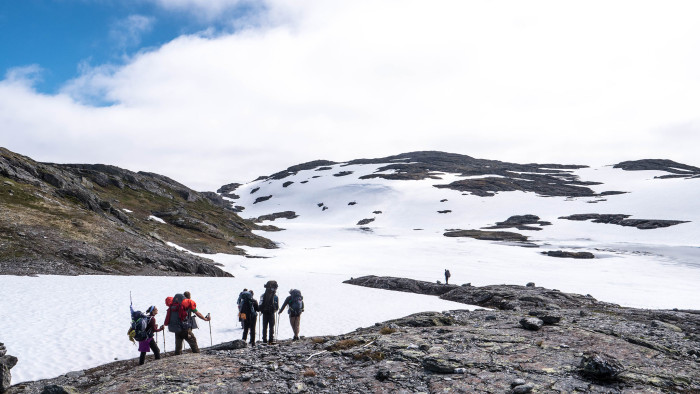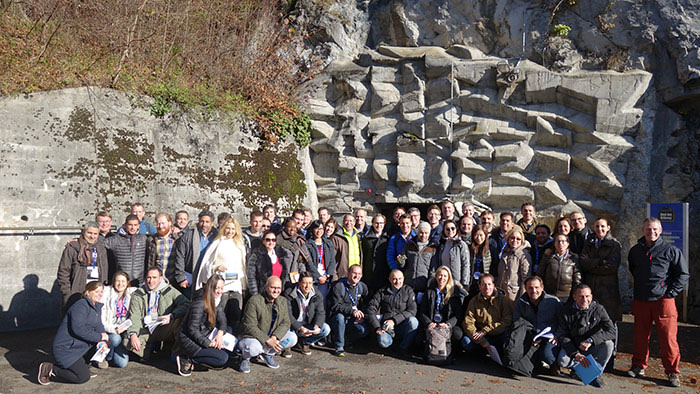EMBA courses in wild locations

Roula Khalaf, Editor of the FT, selects her favourite stories in this weekly newsletter.
In June, executives from some of Britain’s biggest companies were to be found traversing a Norwegian mountain plateau in icy temperatures. The expedition was an option on the executive MBA programme at the University of Exeter Business School and participants had to navigate a route across 50km of trackless terrain in the Hardangervidda national park, near Bergen.
The group did not complete the challenge, but Stuart Robinson, EMBA director at the UK school, who accompanied them, says it was more effective at developing leadership than lectures — though it will not replace them.
“If you learn about economics, then you need to sit in a classroom and read books, as it’s mostly theory,” he says. “But developing leadership traits, including good decision making and emotional intelligence — that can only be done through real-world experiences.”
One EMBA participant, Nigel Ashworth, Europe, Middle East and Africa channel manager at business intelligence company Informa, says the trek made him a stronger communicator. “Every day we had a different group leader,” says the 52-year-old Australian. “I had to discuss the route I wanted to take and get everyone’s buy-in. I learned to articulate my ideas better, motivate others and build trust.”
The trek is one example of the rapid growth of teaching innovation on EMBA programmes. Students and employers are demanding practical learning, says Dan LeClair, chief strategy and innovation officer at AACSB International, the business school accreditation body.
“As employer funding for EMBAs has fallen, fewer students are locked into contracts and [they] are exploring their career options,” he says. “Employers value candidates who can work across industries, geographies and solve complex problems. On practical projects they often do that.”
IMD Business School in Switzerland has increased the practical, or “experiential”, elements of its $108,000 EMBA from 32 per cent in 2008 to 47 per cent today. Comparisons between schools are difficult because they define experiential learning differently.
In 2015, IMD began offering crisis training with the armed forces in an Alpine military bunker as part of its EMBA. It is mandatory for those without health problems. Participants this year ran a fictitious airport and faced problems such as a volcanic ash cloud and a bomb scare. They were deprived of sleep and fed misleading information.

Stefan Michel, dean of the IMD EMBA, says the simulation prepares participants to lead in an uncertain world. “By immersing them in crisis scenarios, they will cope better when faced with real emergencies, such as natural disasters,” he says. “How well they react could define the fate of their career and company.”
IMD EMBA graduate Antje Kanngiesser, vice-president for markets and services at Swiss energy company BKW, says she feels better prepared to make decisions under pressure. “I learnt the importance of delegating duties and establishing an hierarchy in a crisis,” says the Swiss 44-year old. “Otherwise, everyone runs around like headless chickens.” Last year, MIT Sloan School of Management in Massachusetts expanded its “Labs” — mandatory projects on which EMBA students address an organisation’s complex problem, or work on their own start-up.
Students visited Puerto Rico for one recent project, where Hurricane Maria last year destroyed much of the power grid, causing blackouts. They consulted the Puerto Rico Energy Commission on implementing microgrids — energy sources that can operate independently from the main power grid — to help get the Caribbean island’s lights back on.
Daken Vanderburg, 41, founder of Granite Peak Asset Management, says the project taught him how to identify problems more quickly, by communicating directly with stakeholders. “We were on the ground seeing the destruction, talking to businesses, getting to the heart of the problem, rather than sitting in an ivory tower at business school,” the American says.
Some innovative teaching methods are dramatic in other ways. The UK’s Warwick Business School draws on the performing arts to teach leadership. In one EMBA elective, students perform scenes from Shakespearean plays, as well as writing about and enacting workplace dilemmas.
Katy Rogers, national service manager at Kohler Mira, a bathroom products manufacturer, wrote about a personality conflict with a colleague. She says the experience made her more able to understand and express feelings. “It was the best module I did in the EMBA,” says the 40-year-old from the UK. “It has made me more empathetic, which is important because I can better relate to employees. Their engagement has increased, which can improve motivation and productivity levels.”
Jonothan Neelands, professor of creative education at Warwick, says the course improves participants’ public speaking ability. “You take a risk . . . taking a role in a drama scene, which gives you a sense of confidence,” he says.
But making experiential learning accessible for the entire cohort is a problem for business schools, as physical and emotional difficulty can put students off. When Singapore’s NUS Business School irst took part in the Gobi Desert Challenge in 2007, for instance, few EMBA students entered the optional, annual footrace through 112km of desert in China’s Gansu province. Today about 70 per cent of the cohort participate, partly because alumni and administrators have in recent years helped students prepare more thoroughly, such as connecting them with coaches.
Kang Puay Seng completed the challenge in 2014 while studying for an EMBA at NUS. The 57-year-old Singaporean says it improved his resilience. He cites the example of leaving the Mr Bean chain of soya milk stores he co-founded in Singapore, after a disagreement with shareholders, to run a franchise of tea houses.
“The race served me very well, but it’s not everyone’s cup of tea,” he says.
Comments